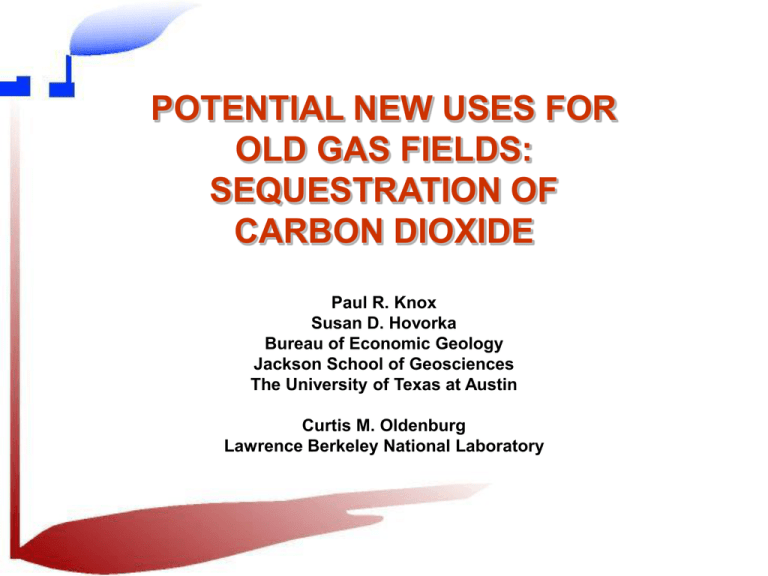POTENTIAL NEW USES FOR OLD GAS FIELDS: SEQUESTRATION OF CARBON DIOXIDE
advertisement

POTENTIAL NEW USES FOR OLD GAS FIELDS: SEQUESTRATION OF CARBON DIOXIDE Paul R. Knox Susan D. Hovorka Bureau of Economic Geology Jackson School of Geosciences The University of Texas at Austin Curtis M. Oldenburg Lawrence Berkeley National Laboratory AGENDA • • • • • • Bureau of Economic Geology Overview of sequestration issues Application in oil and gas fields Enhanced gas recovery Pressure maintenance Wet intervals Summary GLOBAL CLIMATE CHANGE INITIATIVE • “Today, I’m announcing a • • new environmental approach . . .” “We must foster economic growth in ways that protect our environment” “. . . set path to slow GHG emissions, and as science justifies - stop and then reverse that growth” President Bush February 14, 2002 Bureau of Economic Geology Compliments of H.D. Guthrie, NETL, DOE GCCI PATHWAY TO 2012: 200 3400 EIA Reference Case GCCI 180 3000 160 2600 150 MMTCE Gap in 2012 140 2200 120 2000 1800 2004 2008 Greenhouse Gas Emissions (MMTCE) Greenhouse Gas Intensity (TC/$MMGDP) 18% REDUCTION IN GHG INTENSITY 2012 Compliments of S.M. Klara, NETL, DOE THE OPTIONS Reduce Carbon Intensity Sequester Disposal Value-Added Energy efficiency Saline aquifers EOR New technology Deep oceans EGR Biomass ECBM Fuel choice Stop leaks, flares Venting Bureau of Economic Geology ECONOMIC REALITIES • Early sequestration will be in value-added • • • • • Bureau of Economic Geology settings, where geographically available Gas fields: distributed volumes where subsurface is well-known Gulf Coast represents a combination of many CO2 sources and high-injectivity intervals Pipeline networks provide deliverability Mechanisms to address emissions credits are in the planning stages Major oil companies have demonstrated significant interest in geologic sequestration APPLICATION TO OIL AND GAS FIELDS GWC GOC OWC WET INTERVAL Bureau of Economic Geology Brine-bearing Ss. Oil-bearing Ss. Gas-bearing Ss. CO2-bearing Ss. DENSITY OF CO2 AND METHANE 800 CO2 40°C 600 60°C 80°C 400 Gaslike CO2 Liquidlike CO2 200 CH4 40°C 60°C 80°C 0 0 50 100 P (bar) Bureau of Economic Geology 150 200 QAd1546c VISCOSITY OF CO2 AND METHANE CO2 7.0E-05 40°C 6.0E-05 5.0E-05 60°C 80°C 4.0E-05 3.0E-05 CH4 2.0E-05 80°C 0 50 60°C 100 P (bar) Bureau of Economic Geology 40°C 150 200 QAd1547c AGENDA • • • • • • Bureau of Economic Geology Overview of sequestration issues Application in oil and gas fields Enhanced gas recovery Pressure maintenance Wet intervals Summary MODEL SET-UP CH4 production CO2 injection Gas reservoir Water table 100 m Scenario I – No production during CO2 injection Scenario II – Production rate offsetting injection rate Bureau of Economic Geology QAd1548c MODEL RUNS Scenario II Bureau of Economic Geology PRESSURE AND GAS FRACTION 1 130 I 120 II 110 CH4 Xgas 100 0.8 90 Historical CH4 production 80 0.7 70 60 I P 0.6 50 II 40 0.5 30 1940 1950 1960 1970 1980 Year Bureau of Economic Geology 0.9 1990 2000 2010 QAd1550c Scenario I – No production during CO2 injection Scenario II – Production rate offsetting injection rate INCREMENTAL PRODUCTION 1.5E+08 Historical production period Projected I 1E+08 II 5E+07 No CSEGR 0 1950 1960 1970 1980 1990 2000 2010 2020 Year Bureau of Economic Geology Scenario I – No production during CO2 injection Scenario II – Production rate offsetting injection rate QAd1551c CSEGR: OUTSTANDING ISSUES • Economic Feasibility • Field Testing •Economic feasibility evaluated by Oldenburg, Stevens*, and Benson (2002) using example from California’s largest gas reservoir * Advanced Resources International, Inc. ECONOMIC PARAMETERS • Interval is high-porosity, high-permeability • • • • • • sandstone at 5,000 ft depth (Rio Vista field) 25 injectors (125 MMcfd, 6,500 tons/d) 18 producers (peak 45 – 90 MMcfd) 8 monitor wells 15 years duration Costs included mix of new and recompleted wells, pipelines Produced gas CO2 content:1-5 yrs = 0%, 5-10 yrs = 5%, 10-15 yrs = 25% Methane value ECONOMIC OUTPUT From Oldenburg, Stevens, and Benson (2002) BOTTOM LINE • For CO2/CH4 volume ratio = 1.5, need CO2 cost ~ $10/t. • Economics are sensitive to physical processes, specifically CO2/CH4 volume ratio, mixing, and breakthrough times. • Economic feasibility will be reservoir-specific. • Overall conclusion is that CSEGR will require subsidy under current conditions, but that increases in CH4 price or decreases in CO2 supply costs can make CSEGR profitable at a field like Rio Vista. • Field demonstration project essential to realistic assessment in the Gulf Coast AGENDA • • • • • • Bureau of Economic Geology Overview of sequestration issues Application in oil and gas fields Enhanced gas recovery Pressure maintenance Wet intervals Summary SEQUESTRATION AT THE GAS-OIL CONTACT CO 2 CO 2 Water CO 2 Bureau of Economic Geology Producing oil well Perforations CO 2 injection well Flow of gas and oil into wellbore Producing gas well Flow of CO2 into reservoir QAc8550c AGENDA • • • • • • Bureau of Economic Geology Overview of sequestration issues Application in oil and gas fields Enhanced gas recovery Pressure maintenance Wet intervals Summary WET INTERVALS • • • • • • Bureau of Economic Geology Increase overall sequestration volume Existing subsurface infrastructure Existing surface infrastructure (pipelines) Abundant subsurface data Subsurface activities familiar to local communities and regulators U.S. Department of Energy-funded Gulf Coast pilot in permitting stages BRINE PILOT • Purpose: demonstrate feasibility and • • • monitoring techniques, evaluate model predictions Setting: salt dome flank, Frio sandstone, 5,000 ft depth. Scope: < 5,000 tonnes (90 MMcf) over 20 days of injection Monitoring: tracers, pressure and temperature, logs, seismic BRINE PILOT LOCATION Houston Pilot site Power plants Industrial sources 20 miles Bureau of Economic Geology CONCLUSIONS • Preparations are being made in the event that • • • Bureau of Economic Geology geologic sequestration becomes necessary Sequestration can substantially enhance production from mature gas reservoirs and is economic with low-cost CO2 supplies Sequestration seems a logical option to maintain reservoir pressure and facilitate simultaneous oil and gas production Sequestration has the potential to extend field life, increase ultimate recoveries, increase production rates, and add new revenue streams to mature fields. ACKNOWLEDGEMENTS This work was supported in part by the Assistant Secretary for Fossil Energy, Office of Coal and Power Systems through the National Energy Technology Laboratory, and by Lawrence Berkeley National Laboratory under Department of Energy Contracts No. DE-AC03-76SF00098 and No. DE-AC26-98FT40417

